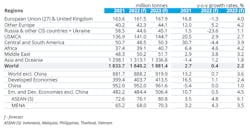Global steel demand growth for 2022 will rise just 0.4% year-over-year, according to the World Steel Assn.’s latest Short Range Outlook report. The ongoing decline, which began in mid-2021, is shaped by Chinese government restrictions on real-estate and construction growth along with rising inflation worldwide and the instability surrounding the Russian invasion of Ukraine.
World Steel, a trade association representing steelmaking businesses in 64 countries, pegged the current year’s global steel demand total at 1.84 billion metric tons, to be followed by a 2.2% rise in 2023 to 1.89 billion metric tons.
“This Short Range Outlook is issued in the shadow of the human and economic tragedy following the Russian invasion of Ukraine,” commented Máximo Vedoya, chairman of the World Steel Economics Committee. “For 2022 and 2023, the outlook is highly uncertain. The expectation of a continued and stable recovery from the pandemic has been shaken by the war in Ukraine and rising inflation.”
In its previous SRO, World Steel set the 2022 demand target at 1.89 billion metric tons, which was a downgrade from the preceding forecast level of 1.92 billion metric tons. The global industry had rebounded in the first half of 2021, but by midyear a slowdown had begun – starting in China.
Vedoya continued: “In 2021, recovery from the pandemic shock turned out to be stronger than expected in many regions, despite continuing supply chain issues and COVID waves. However, a sharper than anticipated deceleration in China led to lower global steel demand growth in 2021.”World Steel puts much of the current uncertainty for steel demand on the war – in particular for the economies of Ukraine, Russia, and the European Union due to its proximity to the conflict.
However, it added that the impact will be felt globally due to higher energy and commodity prices and continued supply-chain disruptions, followed by financial market volatility and heightened uncertainty that will weaken new investment.
Regionally, steel demand will remain flat in China despite central government efforts to stimulate infrastructure investment, while working to stabilize real-estate investments. New stimulus efforts in China are seen having a “small positive growth in steel demand in 2023,” with some potential for more stimulus if the Chinese economy faces more external pressure.Steel demand in the developed economies (North America, the E.U.) has grown weaker since the 2021 recovery thanks to inflationary pressure, as well as the Russian invasion in Ukraine. “Steel demand in the developed world is forecast to increase by 1.1% and 2.4% in 2022 and 2023 respectively, after recovering by 16.5% in 2021,” according to World Steel.
In regard to steel consumption indicators, the World Steel forecast sees global construction activity straining to grow against inflation and rising interest rates. Government stimulus programs to drive infrastructure spending, along with investments related to “the energy transition”, are likely to be the source of most of the growth in construction-related demand for steel, according to World Steel.
The automaking industry has not rebounded as well as other sectors have done from the Covid-related decline, in particular due to supply-chain restrictions in the second half of 2021. The Russia-Ukraine war is likely to prolong this problem, particularly in Europe.








